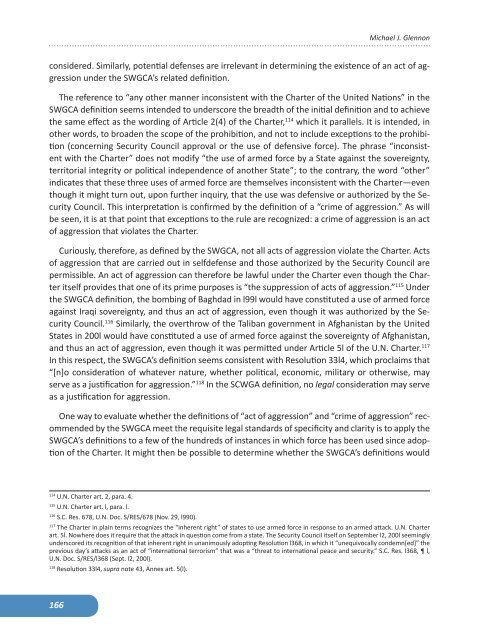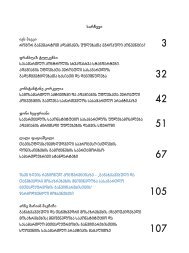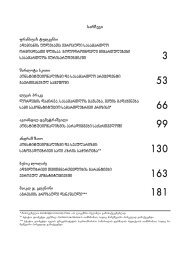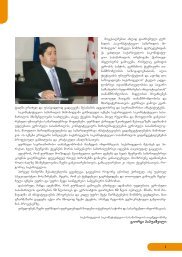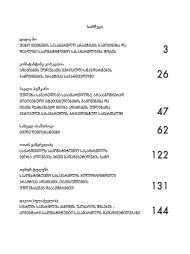Contents - Constitutional Court of Georgia
Contents - Constitutional Court of Georgia
Contents - Constitutional Court of Georgia
You also want an ePaper? Increase the reach of your titles
YUMPU automatically turns print PDFs into web optimized ePapers that Google loves.
166<br />
Michael J. Glennon<br />
considered. Similarly, potential defenses are irrelevant in determining the existence <strong>of</strong> an act <strong>of</strong> aggression<br />
under the SWGCA’s related definition.<br />
The reference to “any other manner inconsistent with the Charter <strong>of</strong> the United Nations” in the<br />
SWGCA definition seems intended to underscore the breadth <strong>of</strong> the initial definition and to achieve<br />
the same effect as the wording <strong>of</strong> Article 2(4) <strong>of</strong> the Charter, 114 which it parallels. It is intended, in<br />
other words, to broaden the scope <strong>of</strong> the prohibition, and not to include exceptions to the prohibition<br />
(concerning Security Council approval or the use <strong>of</strong> defensive force). The phrase “inconsistent<br />
with the Charter” does not modify “the use <strong>of</strong> armed force by a State against the sovereignty,<br />
territorial integrity or political independence <strong>of</strong> another State”; to the contrary, the word “other”<br />
indicates that these three uses <strong>of</strong> armed force are themselves inconsistent with the Charter—even<br />
though it might turn out, upon further inquiry, that the use was defensive or authorized by the Security<br />
Council. This interpretation is confirmed by the definition <strong>of</strong> a “crime <strong>of</strong> aggression.” As will<br />
be seen, it is at that point that exceptions to the rule are recognized: a crime <strong>of</strong> aggression is an act<br />
<strong>of</strong> aggression that violates the Charter.<br />
Curiously, therefore, as defined by the SWGCA, not all acts <strong>of</strong> aggression violate the Charter. Acts<br />
<strong>of</strong> aggression that are carried out in selfdefense and those authorized by the Security Council are<br />
permissible. An act <strong>of</strong> aggression can therefore be lawful under the Charter even though the Charter<br />
itself provides that one <strong>of</strong> its prime purposes is “the suppression <strong>of</strong> acts <strong>of</strong> aggression.” 115 Under<br />
the SWGCA definition, the bombing <strong>of</strong> Baghdad in l99l would have constituted a use <strong>of</strong> armed force<br />
against Iraqi sovereignty, and thus an act <strong>of</strong> aggression, even though it was authorized by the Security<br />
Council. 116 Similarly, the overthrow <strong>of</strong> the Taliban government in Afghanistan by the United<br />
States in 200l would have constituted a use <strong>of</strong> armed force against the sovereignty <strong>of</strong> Afghanistan,<br />
and thus an act <strong>of</strong> aggression, even though it was permitted under Article 5l <strong>of</strong> the U.N. Charter. 117<br />
In this respect, the SWGCA’s definition seems consistent with Resolution 33l4, which proclaims that<br />
“[n]o consideration <strong>of</strong> whatever nature, whether political, economic, military or otherwise, may<br />
serve as a justification for aggression.” 118 In the SCWGA definition, no legal consideration may serve<br />
as a justification for aggression.<br />
One way to evaluate whether the definitions <strong>of</strong> “act <strong>of</strong> aggression” and “crime <strong>of</strong> aggression” recommended<br />
by the SWGCA meet the requisite legal standards <strong>of</strong> specificity and clarity is to apply the<br />
SWGCA’s definitions to a few <strong>of</strong> the hundreds <strong>of</strong> instances in which force has been used since adoption<br />
<strong>of</strong> the Charter. It might then be possible to determine whether the SWGCA’s definitions would<br />
114 U.N. Charter art. 2, para. 4.<br />
115 U.N. Charter art. l, para. l.<br />
116 S.C. Res. 678, U.N. Doc. S/RES/678 (Nov. 29, l990).<br />
117 The Charter in plain terms recognizes the “inherent right” <strong>of</strong> states to use armed force in response to an armed attack. U.N. Charter<br />
art. 5l. Nowhere does it require that the attack in question come from a state. The Security Council itself on September l2, 200l seemingly<br />
underscored its recognition <strong>of</strong> that inherent right in unanimously adopting Resolution l368, in which it “unequivocally condemn[ed]” the<br />
previous day’s attacks as an act <strong>of</strong> “international terrorism” that was a “threat to international peace and security.” S.C. Res. l368, l,<br />
U.N. Doc. S/RES/l368 (Sept. l2, 200l).<br />
118 Resolution 33l4, supra note 43, Annex art. 5(l).


